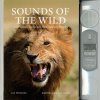Art / Photobook
By: Jan Pedersen(Author), Christopher Westhorp(Editor), Greg McIvor(Translated by)
264 pages, 250+ colour photos, in-built sound module
![Sounds of the Wild Sounds of the Wild]()
Click to have a closer look
About this book
Customer reviews
Biography
Related titles
About this book
Language: English
A sound book, following up on the highly successful Birdsong, and widening the scope to the whole of the animal kingdom. A total of 100 animals are presented in Sounds of the Wild and on the accompanying sound unit: bears, wolves, deer, elephants, whales and birds of paradise to name just a few. Includes over 250 photos.
Sound samples are listed below
- Baboon
- Black-and-White Colobus
- Blue Monkey
- Great Blue Turaco
- Chimpanzee (1/4)
- Chimpanzee (2/4)
- Chimpanzee (3/4)
- Chimpanzee (4/4)
- Frog
- Cicada
- African Cicada
- Australian Cicada
Customer Reviews
Biography
Jan Pedersen is a photographer, author and adventurer with a passion for birds and wildlife dating back to his high school years. He has worked as a bird ringer and researcher, and after completing his university degree worked as an inspector and guide in Sweden’s nature reserves. He has led wildlife holidays and expeditions throughout the world for more than 25 years and has observed and come close to most of the species portrayed in this book. Jan writes for newspapers and magazines about wildlife, conservation, travel and eco-tourism. He often undertakes speaking engagements and is a popular leader of wildlife photography courses. His first book, I Arabiens öknar (“In the Deserts of Arabia”), which won the WWF Panda Book of the Year Award for children and young people in 2000, was the product of 17 camel expeditions with Bedouin in the Arabian Desert. His second title, Sveriges fåglar – fälthandbok för alla (“Birds of Sweden – A Popular Field Guide”), co-written with Göran Bridén and Jony Eriksson, was published in 2008. His third book, Birdsong, co-authored with Lars Svensson, was a book with sound and became a best-seller in Finland and Sweden. Sounds of the Wild is the result of half a life spent in many of the world’s most exciting natural environments. Jan is at home in the wettest rainforests of Africa or South America and the driest deserts of Asia or Australia, always looking for new photographs and stories to raise interest in wildlife and to support eco-tourism and the conservation of vulnerable species and their habitats.
Art / Photobook
By: Jan Pedersen(Author), Christopher Westhorp(Editor), Greg McIvor(Translated by)
264 pages, 250+ colour photos, in-built sound module



























